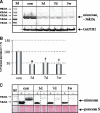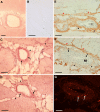The proteoglycan osteoglycin/mimecan is correlated with arteriogenesis
- PMID: 18979232
- PMCID: PMC2758385
- DOI: 10.1007/s11010-008-9935-x
The proteoglycan osteoglycin/mimecan is correlated with arteriogenesis
Abstract
Arteriogenesis or collateral growth is able to compensate for the stenosis of major arteries. Using differential display RT-PCR on growing and quiescent collateral arteries in a rabbit femoral artery ligation model, we cloned the rabbit full-length cDNA of osteoglycin/mimecan. Osteoglycin was present in the adventitia of collateral arteries as a glycosylated protein without keratan sulfate side chains, mainly produced by smooth muscle cells (SMCs) and perivascular fibroblasts. Northern blot, Western blot, and immunohistochemistry confirmed a collateral artery-specific downregulation of osteoglycin from 6 h to 3 weeks after the onset of arteriogenesis. Treatment of primary SMCs with the arteriogenic protein fibroblast growth factor-2 (FGF-2) resulted in a similar reduction of osteoglycin expression as observed in vivo. Application of the FGF-2 inhibitor polyanethole sulfonic acid (PAS) blocked the downregulation of osteoglycin and interfered with arteriogenesis. From our study we conclude that downregulation of osteoglycin is a fundamental requirement for proper arteriogenesis.
Figures






Similar articles
-
Involvement of the fibroblast growth factor system in adaptive and chemokine-induced arteriogenesis.Circ Res. 2003 Mar 21;92(5):561-8. doi: 10.1161/01.RES.0000061181.80065.7D. Epub 2003 Feb 13. Circ Res. 2003. PMID: 12600883
-
Induction of smooth muscle cell migration during arteriogenesis is mediated by Rap2.Arterioscler Thromb Vasc Biol. 2011 Oct;31(10):2297-305. doi: 10.1161/ATVBAHA.111.232835. Epub 2011 Jul 7. Arterioscler Thromb Vasc Biol. 2011. PMID: 21737786
-
Involvement of neuronal NO synthase in collateral artery growth.Indian J Biochem Biophys. 2011 Aug;48(4):270-4. Indian J Biochem Biophys. 2011. PMID: 22053696
-
Arteriogenesis: role of nitric oxide.Endothelium. 2003;10(4-5):207-16. doi: 10.1080/10623320390246388. Endothelium. 2003. PMID: 14660080 Review.
-
Arteriogenesis, a new concept of vascular adaptation in occlusive disease.Angiogenesis. 2001;4(4):247-57. doi: 10.1023/a:1016094004084. Angiogenesis. 2001. PMID: 12197469 Review.
Cited by
-
Aortic wall proteomic analysis in spontaneously hypertensive rats with a blood pressure decrease induced by 6-week load-free swimming.Biomed Rep. 2015 Sep;3(5):681-686. doi: 10.3892/br.2015.488. Epub 2015 Jul 10. Biomed Rep. 2015. PMID: 26405545 Free PMC article.
-
Proteomic analysis of the extracellular matrix in idiopathic pes equinovarus.Mol Cell Biochem. 2015 Mar;401(1-2):133-9. doi: 10.1007/s11010-014-2300-3. Epub 2014 Dec 4. Mol Cell Biochem. 2015. PMID: 25472880
-
Osteoglycin: An ECM Factor Regulating Fibrosis and Tumorigenesis.Biomolecules. 2022 Nov 11;12(11):1674. doi: 10.3390/biom12111674. Biomolecules. 2022. PMID: 36421687 Free PMC article. Review.
-
Low Levels of Plasma Osteoglycin in Patients with Complex Coronary Lesions.J Atheroscler Thromb. 2018 Nov 1;25(11):1149-1155. doi: 10.5551/jat.43059. Epub 2018 Mar 5. J Atheroscler Thromb. 2018. PMID: 29503411 Free PMC article.
-
Impact of miRNAs on cardiovascular aging.J Geriatr Cardiol. 2015 Sep;12(5):569-74. doi: 10.11909/j.issn.1671-5411.2015.05.011. J Geriatr Cardiol. 2015. PMID: 26512249 Free PMC article. Review.
References
-
- WHO (1999) WHO Library Cataloguing in Publication Data. The world health report 1999: Making a difference I. Title: Making a difference ISBN 92 4 156194 7 (NLM Classification: WA 540.1) ISSN 1020-3311
-
- None
- Schaper W, Piek JJ, Munoz-Chapuli R et al (1999) Collateral circulation of the heart. In: Ware JA, Simons M (eds) Angiogenesis and cardiovascular disease. Oxford University Press, New York, pp 159–198
-
- {'text': '', 'ref_index': 1, 'ids': [{'type': 'DOI', 'value': '10.1161/01.RES.0000242560.77512.dd', 'is_inner': False, 'url': 'https://doi.org/10.1161/01.res.0000242560.77512.dd'}, {'type': 'PubMed', 'value': '16931799', 'is_inner': True, 'url': 'https://pubmed.ncbi.nlm.nih.gov/16931799/'}]}
- Eitenmuller I, Volger O, Kluge A et al (2006) The range of adaptation by collateral vessels after femoral artery occlusion. Circ Res 99:656–662. doi:10.1161/01.RES.0000242560.77512.dd - PubMed
-
- {'text': '', 'ref_index': 1, 'ids': [{'type': 'PubMed', 'value': '12692088', 'is_inner': True, 'url': 'https://pubmed.ncbi.nlm.nih.gov/12692088/'}]}
- Deindl E, Ziegelhoffer T, Kanse SM et al (2003) Receptor-independent role of the urokinase-type plasminogen activator during arteriogenesis. FASEB J 17:1174–1176 - PubMed
-
- {'text': '', 'ref_index': 1, 'ids': [{'type': 'PubMed', 'value': '9321814', 'is_inner': True, 'url': 'https://pubmed.ncbi.nlm.nih.gov/9321814/'}]}
- Ito WD, Arras M, Winkler B et al (1997) Angiogenesis but not collateral growth is associated with ischemia after femoral artery occlusion. Am J Physiol 273:H1255–H1265 - PubMed
MeSH terms
Substances
LinkOut - more resources
Full Text Sources
Other Literature Sources

